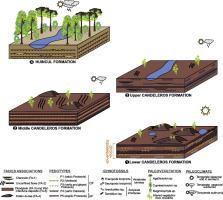Palaeogeography, Palaeoclimatology, Palaeoecology ( IF 2.6 ) Pub Date : 2021-06-30 , DOI: 10.1016/j.palaeo.2021.110549 Sabrina Lizzoli , M. Sol Raigemborn , Augusto N. Varela

|
Although interactions between eolian and fluvial systems are well documented in both modern and ancient environments, there are few studies of such deposits that also address the paleosols that developed within them. The Cenomanian Candeleros and Huincul formations of the Neuquén Basin, Northern Patagonia, Argentina, provides an excellent opportunity to do so. These formations preserve mixed fluvial-eolian and fluvial systems, respectively, with associated pedogenesis. We identify five lithofacies associations (fluvial channel deposits [FA1], deposits of unconfined fluvial flows [FA2], floodplain deposits [FA3], eolian-dune deposits [FA4], and wet interdune deposits [FA5]), and five pedotypes (calcic Protosols [P1], Vertisols [P2], vertic and gleyed Protosols [P3a and P3b, respectively], vertic Calcisols [P4], and argillic Protosols [P5]). The lower Candeleros Formation is characterized by eolian dune deposits with calcic Protosols and wet interdune deposits with Vertisols and vertic and gleyed Protosols. The middle part of the formation is dominated by deposits of unconfined fluvial flows with vertic Protosols and, in the upper part of the unit, there are channel deposits with vertic Calcisols. The Huincul Formation is characterized by fluvial deposits with argillic Protosols.
Changes in paleosol development have been recorded throughout the two formations. Small-scale changes, recognized in the lower Candeleros Formation, comprise a chrono-toposequence, in which calcic Protosols, Vertisols, vertic and gleyed Protosols are genetically associated with FA4 and FA5. Calcic Protosols developed on the dunes and gleyed Protosols in the inner part of the interdunes subjected to temporal waterlogging. When the dunes were vegetated and pedogenesis promoted dune fixation, the rate of dune mobility was slow and the ancient soils developed into Vertisols. In turn, the absence of vegetation was linked to a relatively high rate of dune migration, the time of soil development was limited, and, as a result, vertic Protosols were preserved. The analysis of soil-forming factors as large-scale controlling factors showed that throughout the succession, variations on the type of paleosol and the sedimentary environment over time were controlled by changes in ancient climate. Mid-Cretaceous global climate reconstructions suggest that the paleosols developed in northern Patagonia were located near the limit between the Southern Mid-latitude Warm Humid Belt and the Southern Hot Arid Belt. Seasonally arid and semi-arid conditions prevailed in this area, although there was a temporal trend towards a temperate subhumid climate.
中文翻译:

巴塔哥尼亚北部 Cenomanian 时代河流-风积演替中的成土控制
尽管风成和河流系统之间的相互作用在现代和古代环境中都有很好的记录,但很少有关于此类沉积物的研究也涉及其中发育的古土壤。阿根廷巴塔哥尼亚北部内乌肯盆地的 Cenomanian Candeleros 和 Huincul 地层提供了这样做的绝佳机会。这些地层分别保留了混合的河流-风成和河流系统,以及相关的成土作用。我们确定了五种岩相组合(河流河道沉积物 [FA1]、无侧限河流沉积物 [FA2]、漫滩沉积物 [FA3]、风成沙丘沉积物 [FA4] 和湿丘间沉积物 [FA5])和五种类型(钙质沉积物) Protosols [P1]、Vertisols [P2]、vertic 和 gleyed Protosols [分别为 P3a 和 P3b]、vertic Calcisols [P4] 和 argillic Protosols [P5])。Candeleros 组下部的特征是风成沙丘沉积物与钙质原土和湿沙丘间沉积物与 Vertisols 和垂直和 gleyed 原土。地层中部以无侧限河流流沉积为主,垂直原生质溶胶,在单元上部,有垂直钙化溶质的河道沉积。Huincul 组的特征是具有泥质原生溶质的河流沉积物。
整个两个地层都记录了古土壤发育的变化。小规模的变化,在较低的 Candeleros 地层中被识别,包括时间地序,其中钙质原溶胶、Vertisols、垂直和 gleyed Protosols 在遗传上与 FA4 和 FA5 相关。沙丘上发育钙质原溶胶,沙丘内部受时间积水影响的原溶胶发育。当沙丘植被和成土作用促进沙丘固定时,沙丘移动速度缓慢,古老的土壤发展成Vertisols。反过来,没有植被与相对较高的沙丘迁移率有关,土壤发育时间有限,因此,垂直原生土得以保留。对成土因素作为大尺度控制因素的分析表明,在整个演替过程中,古土壤类型和沉积环境随时间的变化受到古气候变化的控制。中白垩世全球气候重建表明巴塔哥尼亚北部发育的古土壤位于南部中纬度暖湿带和南部热干旱带之间的边界附近。该地区盛行季节性干旱和半干旱气候,但有向温带半湿润气候转变的时间趋势。中白垩世全球气候重建表明巴塔哥尼亚北部发育的古土壤位于南部中纬度暖湿带和南部热干旱带之间的边界附近。该地区盛行季节性干旱和半干旱气候,但有向温带半湿润气候转变的时间趋势。中白垩世全球气候重建表明巴塔哥尼亚北部发育的古土壤位于南部中纬度暖湿带和南部热干旱带之间的边界附近。该地区盛行季节性干旱和半干旱气候,但有向温带半湿润气候转变的时间趋势。











































 京公网安备 11010802027423号
京公网安备 11010802027423号